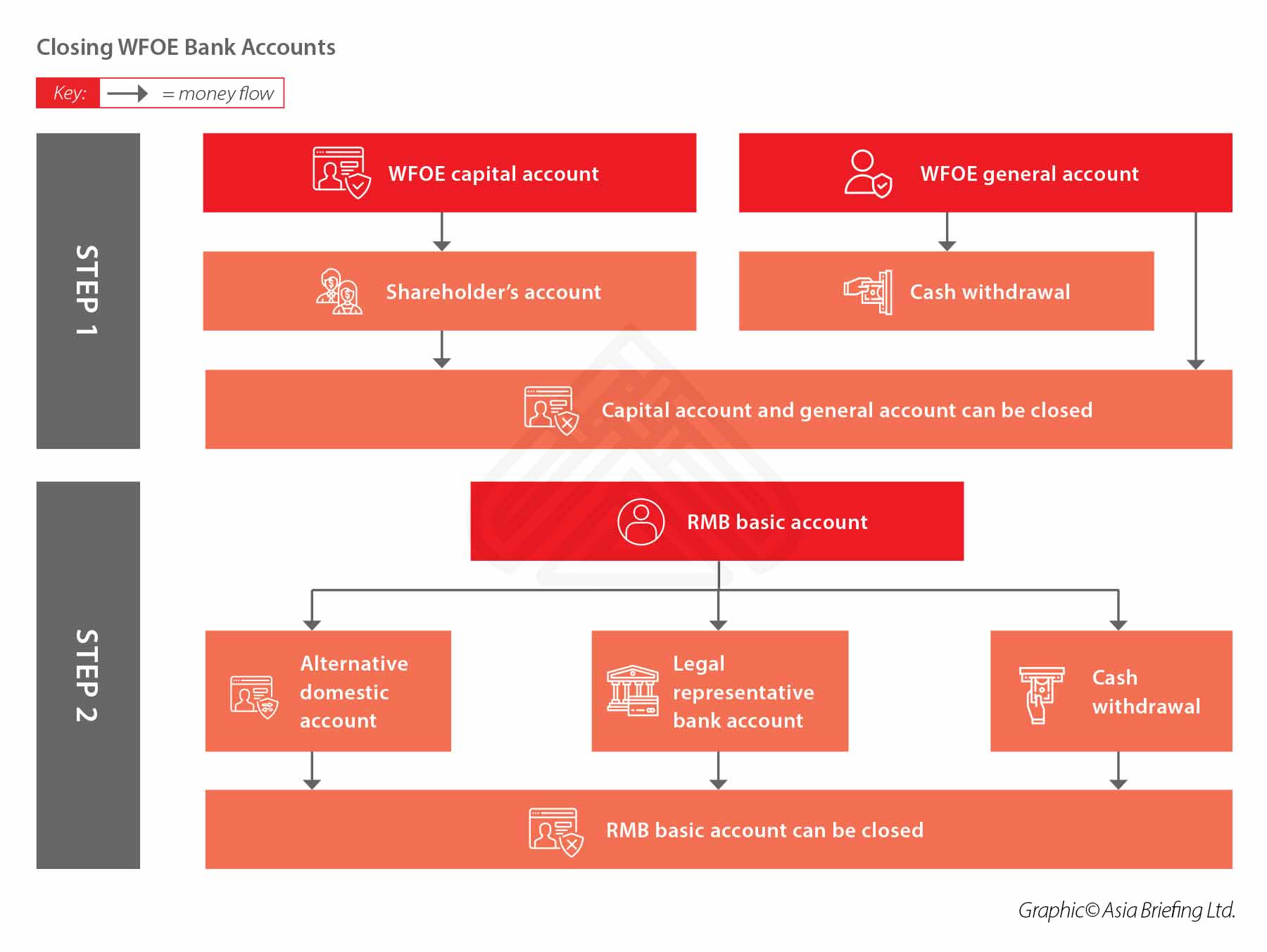Foreign investors may decide to close their business for multiple reasons. To legally close a business, investors need to go through a series of procedures to liquidate and deregister the company, which involves dealing with multiple government agencies, including the respective market regulatory bureaus, foreign exchange administrations, customs, tax departments, banking authorities, and more.
Failing to follow the prescribed procedures will lead to serious consequences for the legal representatives and the company’s future.
Reasons for closure
The most common reasons an enterprise may choose to deregister are voluntary liquidation, a declaration of bankruptcy, the expiration of time-bound business activity defined in the company’s articles of association, merger and subsequent disbandment and dissolution, or relocation.
Procedure
Investors are strongly advised not to "walk away" without following the prescribed procedures. Simply walking away has severe repercussions for the legal representatives and the company's future in China. This includes attracting civil liability due to credit owed or even criminal culpability, difficulty during immigration, loss of property and assets, or inability to make future investments due to damage to reputation and financial status.
Close a WFOE: Step-by-Step
Timeframe: Typically, between six to 14 months.
A WFOE company structure is subject to special attention during its closure procedure, involving more steps and authority involvement than that of its representative office and Chinese company counterparts.
The deregistration process can vary depending on the nature of the WFOE (manufacturing, trading, or service WFOE), its associated business scope, the size and health of the company, and the duration of company operations.
There are some general steps that each WFOE must follow.
Form a liquidation committee and prepare an internal plan
The liquidation committee of a limited liability company should comprise of the company’s director(s), unless otherwise stipulated in the company’s AOA or the shareholders’ meeting appoints other person to act on behalf of the liquidation committee. All the legal documents for the liquidation shall be signed by the person in charge of the liquidation committee.
Throughout the liquidation process, the committee will handle several matters directly concerning the deregistration process, including – notifying the creditors of the business closure, preparing the liquidation report to submit to authorities, as well as more administrative tasks, such as preparing the balance sheet and recording a detailed list of all assets and evaluating properties, conduct the company deregistration formalities with different competent authorities.
The 2023 Company Law, coming into effect from July 1, 2024, clarifies that directors should serve as liquidators in the case of liquidation. Article 232 stipulates that directors shall form a liquidation group within 15 days of the date on which the cause of dissolution arises. The company directors are also members of the liquidation group by default. If the liquidation obligor fails to perform the liquidation obligation in time and causes losses to the company or creditors, they shall be liable for compensation.
Liquidate the assets
The liquidation committee shall, after liquidating the property of the company and preparing a balance sheet and an inventory of property, make a plan of liquidation and report the same to the shareholders' meeting or the People's Court for confirmation. After paying the following fees and costs in the following order,
the remaining assets may, in the case of a limited liability company, be distributed in proportion to the capital contributions of the shareholders, and in the case of a joint stock limited company, distributed in proportion to the shares held by the shareholders:
- Liquidation expenses;
- Outstanding employee salary or social security payments;
- Outstanding tax liabilities; and
- Any other outstanding debts owed by the WFOE.
If the company’s assets are unable to settle the debts, it will file a bankruptcy declaration with the court.
File the liquidation committee with SAMR while notifying creditors through SAMR’s official website
After the liquidation committee is formed, the WFOE must file a record with the State Administration for Market Regulation (SAMR) notifying SAMR of its intent to close the WFOE. This can be completed by submitting a shareholder resolution, which reflects the shareholder(s)’ decision to close the business and announces the names of the members that have been appointed to form the liquidation committee. Meanwhile, WFOE shall make a public announcement on SAMR’s official website to notify its creditors. The notification period is 45 days. If the WFOE is qualified for a simplified deregistration process with SAMR, the filing of the liquidation committee is not required, and the creditor notification period is 20 days.
Begin terminating employees
Businesses are advised to begin terminating employees as early as possible as many adjoining issues may arise once this process is initiated. The WFOE is obliged to pay statutory severance to each employee due to the closing of the WFOE. In addition, the tax clearance process cannot be started if the company continues to pay salary and deduct the IIT on behalf of its employees.
Tax clearance and deregistration
A general tax deregistration process will usually take around four to eight months. During this process, the tax authority will collect a series of relevant documents including:
- The signed board resolution;
- Evidence of lease termination; and,
- Tax filing records for the previous three years.
All outstanding tax liabilities will be identified and required to be settled before deregistering the business from its value-added tax (VAT), corporate income tax (CIT), individual income tax (IIT), and stamp tax obligations.
Businesses that have been operating for more than one year will then be required to complete an audit with a local certified public accountant (CPA) firm to obtain a liquidation report. This liquidation report, along with the unissued invoices, VAT invoices, and equipment, can then be brought to the tax bureau for review. In some instances, the tax bureau may visit the office in person to learn more of the company’s intentions and reasons.
If the review is successful, the tax clearance certificate will be issued, in which case the business will have successfully deregistered from all its tax obligations. The business will incur ongoing tax liabilities throughout the business closure process.
Deregistration processes before the SAMR deregistration
Before the SAMR deregistration application, deregistration at the following departments must be completed:
- All bank accounts (except for the RMB basic account) shall be closed before SAMR deregistration. The balance in those account(s) shall be transferred to the RMB basic account.
- Customs bureau closing: an application letter stamped by the company, along with the original custom registration certificates needs to be submitted to the customs bureau for deregistration. If the WFOE never obtained a registration certificate from the customs, only an explanation letter is required.
These two processes can be conducted concurrently with the tax clearance process.
SAMR deregistration application
Once the official tax clearance certificate has been obtained, the SAMR deregistration process can begin. To do this, the liquidation committee must submit the liquidation report, signed by the shareholder (or its authorized representative), which needs to confirm the following – the completion of tax clearances, the termination of all employees, and that all creditor claims have been settled. A shareholder resolution on the liquidation of the WFOE also needs to be submitted at this stage to get the Deregistration Certificate from the SAMR.
Deregistration processes with other departments
Upon the completion of the SMAR deregistration, the following deregistration processes shall be conducted with the competent departments (where relevant):
- RMB basic account closing
- Bank balance (including liquidated income) shall be repatriated to shareholder(s);
- RMB basic account closing.
- State Administration of Foreign Exchange (SAFE): This needs to be completed through the bank rather than SAFE. The WFOE must make an application at the bank in which their capital account was opened.
- Social insurance bureau: The SAMR deregistration notice needs to be brought to the HR bureau for deregistration.
- Other licenses: Production licenses, food distribution licenses, and others need to be deregistered with the relevant authorities.

Cancel company chops
Once all the other steps are completed, the WFOE can cancel WFOE's chops by itself or by the public security bureau, mainly depending on local policy.
Close an RO: Step-by-Step
Timeframe: Typically, between six months to one year, or longer if irregularities are found.
For a variety of reasons, there may come a time when foreign headquarters need to close their ROs. For example, when a foreign headquarters looks to transform its RO to a WFOE to expand for-profit businesses, it will need to deregister its RO first.
From a legal perspective, China’s regulations stipulate that a foreign enterprise must, within 60 days, apply to the SAMR to deregister the RO when any of the following circumstances occur:
- The RO is required to shut down in accordance with the law;
- The RO no longer engages in business activities upon the expiration of residency;
- The foreign enterprise terminates its RO; or
- The foreign enterprise terminates its business (meaning the parent company is being closed).
The processes of closing an RO and closing WFOE share similarities, but the former is much simpler, as there are no complex liquidation procedures or large-scale employee terminations.
Employee termination
Before the closing processes, all employees worked for RO shall be terminated properly. However, there are a few points that need to be taken care of:
RO’s local employees: RO’s local employees are dispatched by a labor dispatch agency, such as the Foreign Enterprise Human Resources Service Company (FESCO).
The local employees have to sign labor contracts with the dispatching company instead of with the RO and the RO does not have any direct employment relationships with its local employees. As a result, the RO needs to work together with the labor dispatch agency to deal with the employee termination process when laying off a local employee.
The severance shall be paid to each employee due to the closing of RO by the labor dispatch agency, but such money is ultimately paid by RO or its HQ.
RO’s foreign employees including one chief representative and one to three general representatives of the RO – their dismissal must be handled by the RO’s headquarters.
Tax audit
The formal deregistration of an RO starts with the application to the relevant tax bureau for tax clearance and tax deregistration. This step is often considered the longest – around six months – and perhaps the most difficult part of the entire deregistration process, as the tax bureau will ensure that the RO properly and fully pays all the taxes.
As part of the tax deregistration process, the RO must hire a local Chinese-certified public accountant (CPA) firm to audit its accounts for the last three years. The latter will then generate a three-year tax clearance audit report for submission to the tax bureau.
During this phase, it is important to note that the monthly tax filing of the RO shall still be carried as an ongoing activity until all tax closures are completed with the tax bureau.
Tax deregistration
The RO will then need to submit the three-year tax clearance audit report (up to the current month), the tax deregistration application form, the tax registration certificate, vouchers, tax filing records, and other tax-related documents to the tax bureau for review.
If all the taxes are cleared, the tax bureau will issue a tax deregistration certificate to the RO. However, if any unpaid taxes or irregularities are found, the tax bureau may conduct tax clearance for outstanding tax issues or possible on-site inspection of the RO.
The RO may then be required to settle the unpaid taxes, submit additional documentation, or pay penalties.
Deregistration with SAFE and customs
After (or parallel with) the tax deregistration is done, the RO will also need to deregister the foreign exchange certificate with the SAFE and deregister with the Customs. If RO has a general foreign exchange bank account, this account shall be closed before the SAFE deregistration, and the balance in the account must be transferred to RO’s RMB basic bank account.
Obtaining the deregistration certificates from both the SAFE and the Customs is a mandatory step of the RO deregistration process, irrespective of whether the RO has ever obtained a registration certificate from either of these two authorities.
Deregistration with SAMR
The next big step is to officially deregister the RO with the local branch of the SAMR with the following documents:
- The deregistration application letter;
- The tax deregistration certificate;
- Proofs issued by the Customs and SAFE prove that the RO has deregistered the customs and foreign exchange or has never gone through any registration procedures; and
- Other documents as the SAMR prescribed.
After review, the local SAMR will then issue the ‘notice of deregistration’ stating the official termination of the RO. An announcement of the RO’s deregistration will be listed on SAMR’s official website. At this point, all the registration certificates will be cancelled, as well as the chief representative’s work certificate.
Bank account closure
Last, the RO will need to close its RMB basic bank accounts. Unissued checks and deposit slips should be returned to the bank and money in the account must be transferred to RO’s headquarter.
After the deregistration
After the RO has completed the deregistration, it is important that the parent company requests the return of and keeps all accounting records and business documents to safeguard the interest of the parent company.
Finally, the RO’s chops must be destroyed by the RO or its HQ.
Simplified procedures for company deregistration
The SAT has issued the Notice on Further Optimizing the Procedures for Dealing with Enterprise Tax Deregistration (henceforth Notice) to ease the difficulties of enterprise deregistration. The Notice takes measures to reduce enterprises’ repeated errands and to issue tax clearance certificates on the spot even when some enterprises submit incomplete documents.
In particular, the newly introduced commitment system presumes the integrity of the enterprise, which may be reflected in a positive inspection record, high tax credit ratings, and no tax or fines owed. In such situations, the tax clearance time will be unaffected, and only a commitment is needed from the legal representative deregistering the company to provide all tax-related information within a stipulated time period.
New government reforms will follow three directions.
- Simplifying the SAMR deregistration. This aims to see improvement in the general deregistration system for enterprises;
- Simplifying tax, social security, business, customs, and other deregistration procedures as well as document submission requirements; and
- Setting up online service platforms for enterprise deregistration and carrying out “one-stop” online services (or “one website”) to facilitate this.
Through the above measures, the cancellation time of enterprises can be reduced by at least one-third. At the same time, the government will strictly investigate business entities indulging in the evasion of debt. The names and information on enterprises that have lost credibility due to non-compliance or debt evasion will be jointly published by the respective government agencies.








